As the most commonly used Internet access technology, Wi Fi is closely related to everyone's life. Especially in the past two years, due to the epidemic, more and more social activities have been transferred from offline to online, in which Wi Fi has played a huge role, significantly reducing the impact of the epidemic on society and economy. According to the data provided by Cisco network (as shown in Figure 1), in 2021, 50% of the global Internet traffic will come from wi fi**.
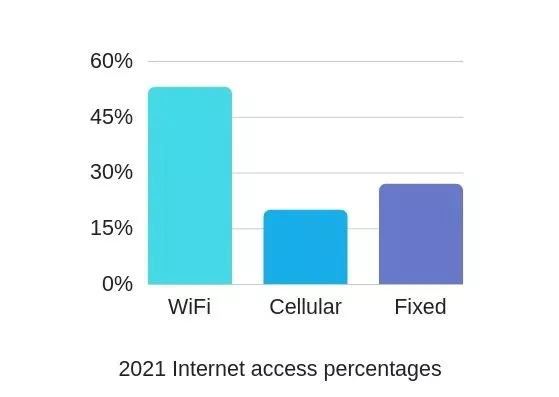
▲ Figure 1 proportion of access technology in 2021 global data traffic (data comes from Cisco Network)
Over the past 20 years, Wi Fi has carried the growing network demand by relying on the only 2.4GHz and 5GHz frequency bands (a total of more than 600 MHz spectrum).
In a previous article (link ) , we talked about some new technologies in Wi Fi 6. These technologies can help alleviate the problem of network congestion.
However, even if wireless engineers can use numerous black technologies to expand network capacity, in recent years, the rapid growth in the number of wireless devices and the increasing demand for speed brought by applications have finally led to spectrum becoming the bottleneck of network capacity.
At present, the 2.4GHz and 5GHz bands used by*wi fi are very crowded *. Reflected in the user experience, the network delay increases, the user rate decreases, and the interference between Wi Fi routers becomes more and more frequent.
In order to meet this challenge, shortly after the launch of Wi Fi 6, *wi fi industry has actively promoted the development of Wi Fi 6e *.
Wi Fi 6e follows the core technology of the current Wi Fi 6 and expands the network capacity by extending the working frequency band of Wi Fi 6 to 6ghz** (5925-7125mhz).
As shown in Figure 2, the newly added 1200MHz has doubled the spectrum resources of Wi Fi .
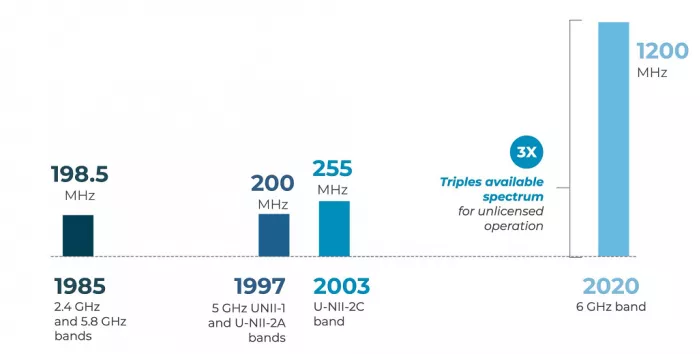
▲ Figure 2 development history of Wi Fi band
The 6GHz spectrum can make a qualitative leap in performance for Wi Fi. As can be seen from Figure 3, *6ghz has doubled the number of Wi Fi channels *.
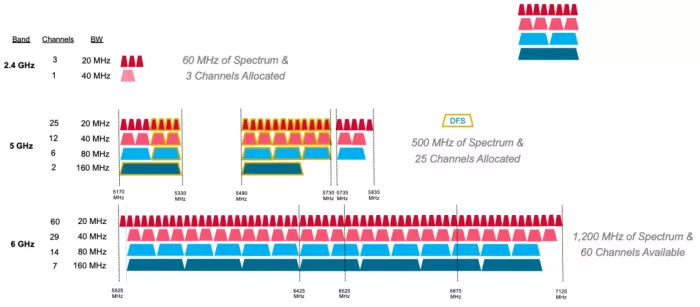
▲ Figure 3 channel number of 2.4, 5 and 6GHz Wi Fi
For the 40MHz channel most commonly used at present, *5ghz can provide 4 ordinary channels and 8 DFS channels *. (Note: the function of DFS channel is to protect the frequency used by radar from interference. When Wi Fi equipment detects that radar is using this frequency band, Wi Fi will automatically avoid this channel)
On 6GHz, there are up to 29 40MHz channels not limited by DFS, which can be selected by Wi Fi devices.
█ why do you need so many channels?
To answer this question, we need to treat each node of the network as a whole.
From mobile phones and computers to wireless routing and subsequent optical networks, the performance of the network cannot be improved if any node has a bottleneck. In the past, in the era of 10 to 100 gigabit optical fiber, the bottleneck of network speed often lies in the optical fiber network itself. Simply increasing the Wi Fi rate does not make much sense to the overall performance of the network.
Nowadays, with the promotion of the national dual Gigabit infrastructure project, more and more families can use gigabit optical networks, and the rate of enterprise optical networks can reach 10GB.
Optical fiber technology is constantly updated. Optical fiber technology above 50Gbps appeared under the development blueprint of the International Telecommunication Union (ITU) as early as 2018. It is expected that commercial products will appear soon.
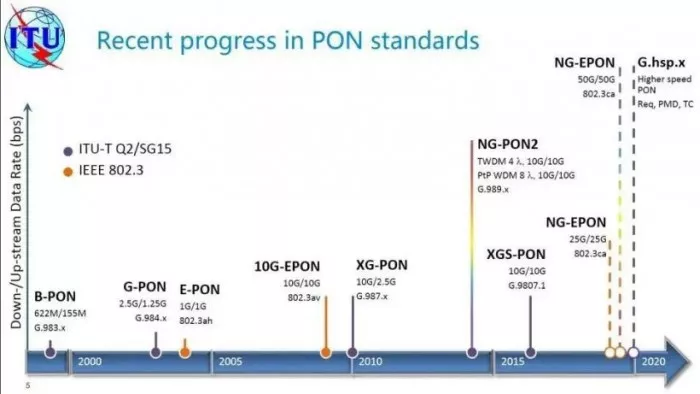
▲ Figure 4 ITU optical fiber technology development blueprint
In the past, *wi fi devices mainly used 20MHz and 40MHz bandwidths *. Our mobile phones and pads are usually equipped with two Wi Fi antennas to support MIMO.
According to the data rate calculation table given by Aruba network in Figure 5, the theoretical maximum rate of Wi Fi devices with 2-channel MIMO and 64QAM modulation can only reach about 344mbps under the bandwidth of 40MHz. (Note: higher order modulation requires excellent wireless channel signal-to-noise ratio, which is difficult to meet in daily life.)
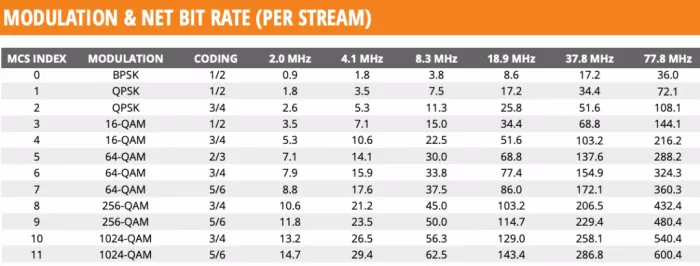
▲ Figure 5 theoretical maximum data rate of single channel of Wi Fi 6
When users already own gigabit optical fiber, such Wi Fi performance has become a bottleneck in the network. At this point, it makes sense to increase the rate of Wi Fi.
By increasing the bandwidth to 80MHz, the maximum speed can exceed 700mbps**, and the 160MHz bandwidth can fully meet the requirements of gigabit optical fiber.
From the analysis of users' router usage, the trend of increasing bandwidth can also be verified. According to the analysis of Cisco and Aruba on their users, at present, 80MHz bandwidth has gradually become the default option for households and enterprises when configuring Wi Fi networks .
After writing here, you may have a question. Didn't the last article mention that OFDMA, high-order modulation and more MIMO technologies can improve the rate and network capacity? Why do you need to increase channel resources?
In fact, the reason is very simple. There is no free lunch.
Although MIMO can provide multiple channels to increase the data rate, the first cost is that the increased channels need corresponding transceiver channels, which increases the power consumption of Wi Fi devices.
Second, the introduction of higher-order modulation and multi-channel MIMO means that the RF receiver has higher requirements for the signal-to-noise ratio of the wireless channel, which reduces the cell coverage and the anti-interference degree of the equipment.
The fundamentality of OFDMA lies in how to allocate the cake to users more effectively, but not make the cake bigger. Therefore, the most direct and effective way to increase capacity is to broaden bandwidth and increase spectrum resources.
You may still have questions. Can Wi Fi 6 on 5GHz also support 80 and 160MHz bandwidth? Why Wi Fi 6e?
To answer this question, we need to discuss it from the perspective of network multi router deployment.
At present, the industry's gold standard for the deployment of intensive Wi Fi networks is the 7-channel reuse scheme. This scheme is the best optimization point to balance spectrum efficiency and inter cell interference.
The so-called 7-channel reuse scheme refers to six adjacent routes around a wireless route, all using different Wi Fi channels.
Take the Wi Fi deployment of the office space on the first floor in Figure 6 as an example.
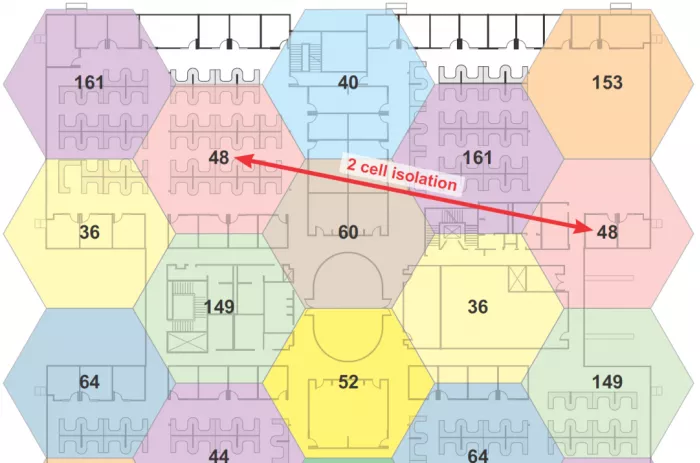
▲ Figure 6 7 channel Wi Fi cell deployment scheme
With the 7-channel reuse scheme, Wi Fi cells with the same frequency can be separated from each other by two cells with different frequencies. Due to the long distance, the risk of CO frequency interference between cells is very small.
In the past, on the basis of 40MHz channel, this deployment has no pressure on the spectrum.
However, when users upgrade the channel to 80MHz bandwidth, the current 5GHz spectrum is not enough.
At this point, Wi Fi 6e comes in handy.
From the above channel diagram, we can see that 6GHz has up to 14 80MHz channels , which can fully meet the requirements. Even if users upgrade to 160MHz bandwidth in the future, 6GHz can still provide 7 channels to meet network deployment.
█ current global development of Wi Fi 6e
Wi Fi 6e devices generally support the entire 6GHz, but in the specific usable frequency range, equipment manufacturers need to meet the frequency band requirements of various countries .
There are two main directions for the spectrum allocation of 6GHz Wi Fi in the world. The first is the one-step mode based on ITU region 2 (America), that is, the entire 1.2Ghz spectrum (5925-7125mhz) is open to Wi Fi.
The second is a step-by-step approach. First, 500MHz in the low 6GHz frequency band (5925-6425mhz) is opened for Wi Fi, while the high 6GHz (6425-7125mhz) planning continues to take a wait-and-see attitude.
The regions holding this strategy are mainly the European Union, Australia, Japan and other countries.
One of the main reasons is that an important topic in wrc-23 agenda 1.2 has an impact on the spectrum division of these countries and regions.
In this issue, 6425-7125mhz frequency band may be identified as mobile communication frequency band in some areas for future 5g or even 6G use. China is also one of the active supporters of this issue.
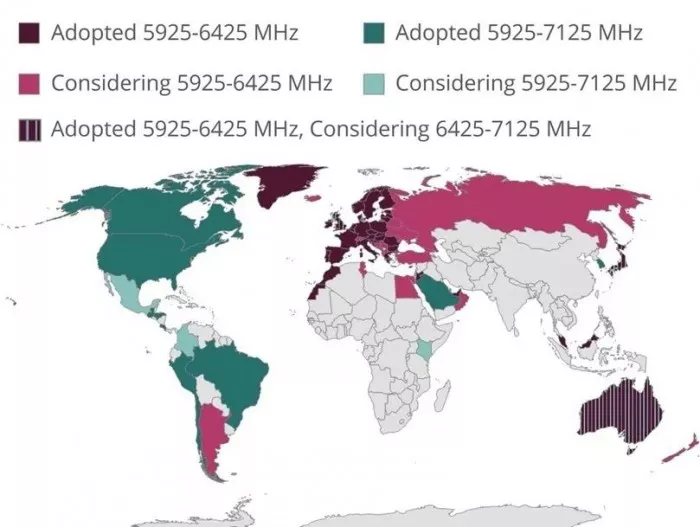
▲ Figure 7 development of global Wi Fi 6e (data from Wi Fi alliance)
Since 2021, there have been a large number of terminals and network devices supporting Wi Fi 6e . At present, the whole Wi Fi 6e ecosystem has a good momentum of development, it is expected that more mainstream devices will start to support Wi Fi 6e this year.

▲ figure 8 Wi Fi 6e ecosystem
█ will China approve the use of Wi Fi 6e?
On the issue of 6GHz, the attitude of the Ministry of industry and information technology before and after wrc-19 has always been to support the allocation of the entire 6GHz to 5g and future 6G mobile communications. Wi Fi 6e has not received much attention in China.
This has a lot to do with our country's 5g industrial policy and the current number of available spectrum in 5g band.
According to the following data released by Qualcomm, China's 5g spectrum in the medium band is only 100MHz at 2.6GHz and 300MHz at 3.5GHz, including 3.3-3.4ghz specially allocated to indoor 5g.
In general, the total amount of mid band spectrum is less than that of EU, North America, Japan and South Korea.
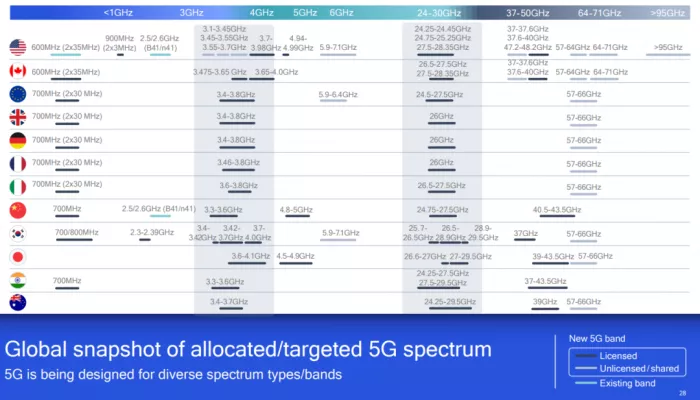
▲ Figure 9 global 5g spectrum allocation (data from Qualcomm)
However, since last year, the Hong Kong SAR government has taken the lead in planning the use of Wi Fi 6e in Hong Kong. In the public opinion solicitation issued by the SAR government last year, the impact of the current congestion of Wi Fi networks on enterprises and individuals was mentioned.
After several months of consultation and discussion, in the final decision-making document issued by the Hong Kong Communications Authority in April this year, Hong Kong adopted a step-by-step model, that is, following the European Union, first open the low 500MHz in 6GHz to Wi Fi. For high 700MHz, Hong Kong will pay attention to the discussion of wrc-23 agenda 1.2.
I have attached the policy document of the Communications Administration Bureau in the references. Interested students can study it by themselves.
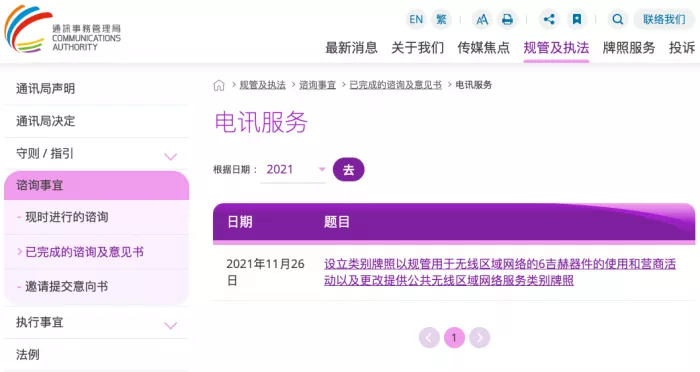
▲ Figure 10 wi-f i6e public opinion solicitation form of Hong Kong Communications Authority
This spectrum policy in Hong Kong gives people a glimpse of the dawn of Wi Fi 6e in mainland China.
From the past C-band and millimeter wave 5g planning, Hong Kong and the mainland are basically the same, but the release time of the policy is often one step ahead of the mainland. If this law holds, in terms of 6GHz spectrum planning, the Ministry of industry and information technology may consider the demand for Wi Fi .
In fact, the Wi Fi network congestion problem is not only in Hong Kong, but also in large and medium-sized cities in the mainland. In order to improve the performance of enterprise and home networks in the future, 5g alone is not enough in terms of enterprise cost, equipment ecology and the load capacity of the three operators.
In addition, even if it cannot be compared with ZTE, Huawei and China Mobile, which have great influence in the international mobile communication industry, China also has large companies in the Wi Fi industry, such as Xinhua III, Fiberhome and tp link. Even the enterprise network business departments of ZTE and Huawei are important partners of the Wi Fi ecosystem.
If 6GHz is fully allocated to mobile communications, it will be a major blow to enterprises whose main business is Wi Fi products and services. In particular, the future development of Wi Fi 7 in China will largely depend on whether there are enough spectrum resources.
From the development history of technology at home and abroad, the update of technology is often unpredictable. Led by the government policy, there is often a risk of misjudgment when putting all your eggs in one basket for a certain technology.
Industrial policies are generally less effective than market policies in terms of the long-term vitality of the market and the international competitiveness of products. Allowing enterprises to determine the future direction of technological development through fair market competition will not only make the distribution of capital more reasonable, the allocation of resources more effective, but also enable enterprises to have stronger vitality.
█ the future of Wi Fi
Wi Fi technology is still being updated.
Shortly after the advent of Wi Fi 6 in 2019, the 802.11 working group began the research on the next generation of Wi Fi technology - Wi Fi 7* The academic name of Wi Fi 7 is 802.11be. It uses the same spectrum resources as the current Wi Fi 6e *.
At present, the Wi Fi 7 standard work is still in full swing, and the first release has been determined at the beginning of this year. The complete standard work can only be finalized after 2024. The certified Wi Fi 7 devices will not be popularized in the market until 2025.
I will focus on the key technologies of Wi Fi 7 in the next issue.
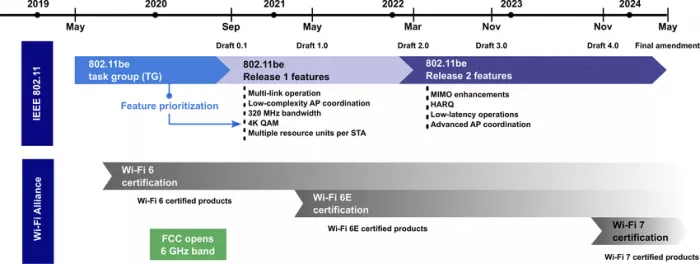
▲ Figure 11 time node of Wi Fi 7
The author, Dr. tangxin, currently serves as the technical director of spectrum lab.
References
[1] Aruba Networks white paper — Technical Guide to Wi-Fi 6e and the 6 GHz band.
[2] Wi-Fi Alliance – Countries Enabling Wi-Fi 6E.
[3] Qualcomm, 5G spectrum innovation and global update.
[3] Hong Kong Communications Authority - establishment of class licences to regulate the use and business activities of 6 GHz devices used in wireless area networks and change the class licence for the provision of public wireless area network services
[4] Khorov, E., Levitsky, I., & Akyildiz, I. F. (2020). Current status and directions of IEEE 802.11be, the future Wi-Fi 7.